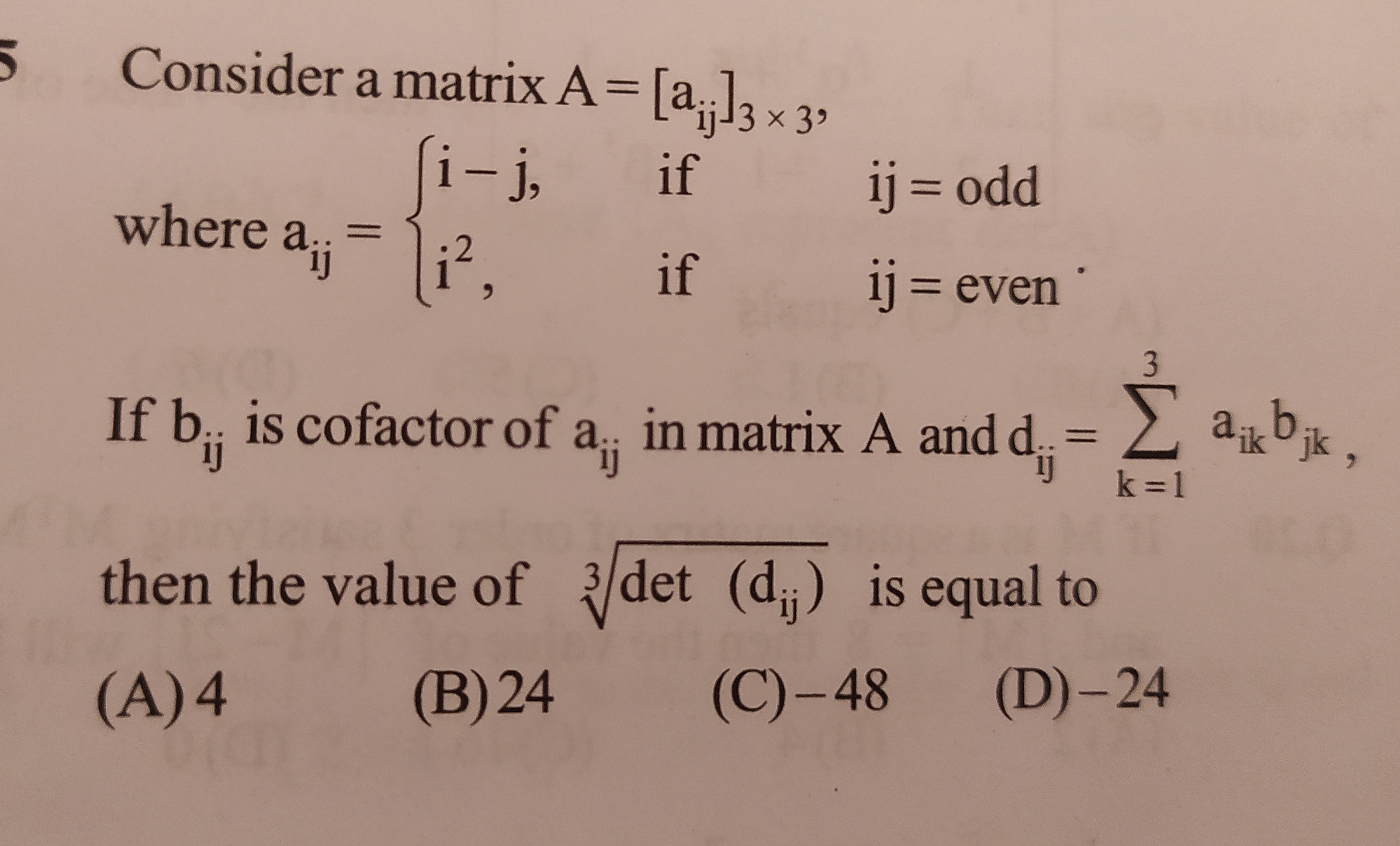Question
Question: Consider a matrix $A = [a_{ij}]_{3 \times 3}$, where $a_{ij} = \begin{cases} i-j, & \text{if} \quad ...
Consider a matrix A=[aij]3×3, where aij={i−j,i2,ifij=oddifij=even.
If bij is cofactor of aij in matrix A and dij=∑k=13aikbjk, then the value of 3det(dij) is equal to

4
24
-48
-24
-48
Solution
The matrix A is given by A=[aij]3×3, where aij={i−j,i2,ifij=oddifij=even.
Let's determine the elements of the matrix A: The product ij is odd if and only if both i and j are odd. The product ij is even if either i or j (or both) is even.
For i=1: a11: 1×1=1 (odd). a11=1−1=0. a12: 1×2=2 (even). a12=12=1. a13: 1×3=3 (odd). a13=1−3=−2.
For i=2: a21: 2×1=2 (even). a21=22=4. a22: 2×2=4 (even). a22=22=4. a23: 2×3=6 (even). a23=22=4.
For i=3: a31: 3×1=3 (odd). a31=3−1=2. a32: 3×2=6 (even). a32=32=9. a33: 3×3=9 (odd). a33=3−3=0.
So, the matrix A is: A=042149−240
We are given that bij is the cofactor of aij in matrix A. We are asked to find the value of 3det(dij), where dij=∑k=13aikbjk.
Let D be the matrix with elements dij. The expression dij=∑k=13aikbjk is the element in the i-th row and j-th column of the matrix product A(adj(A))T, where adj(A) is the adjugate matrix of A. The elements of adj(A) are (adj(A))ij=bji. So, the elements of (adj(A))T are ((adj(A))T)ij=(adj(A))ji=bij. Thus, dij=∑k=13aik((adj(A))T)kj=∑k=13aikbjk.
Alternatively, we know the property that for a matrix A and its cofactors bij, ∑k=1naikbjk=det(A)δij, where δij is the Kronecker delta (δij=1 if i=j and δij=0 if i=j). So, dij=det(A)δij.
This means the matrix D is a diagonal matrix: D=det(A)000det(A)000det(A)=det(A)I, where I is the 3×3 identity matrix.
The determinant of D is det(D)=det(det(A)I). For a scalar c and an n×n matrix M, det(cM)=cndet(M). Here, c=det(A), M=I, and n=3. So, det(D)=(det(A))3det(I)=(det(A))3×1=(det(A))3.
The value we need to find is 3det(dij)=3det(D)=3(det(A))3. Since det(A) is a real number for a real matrix A, 3(det(A))3=det(A).
Now, we need to calculate the determinant of matrix A. A=042149−240
We can calculate det(A) by expanding along the first row: det(A)=0⋅det(4940)−1⋅det(4240)+(−2)⋅det(4249) det(A)=0−1⋅(4×0−4×2)−2⋅(4×9−4×2) det(A)=−1⋅(0−8)−2⋅(36−8) det(A)=−1⋅(−8)−2⋅(28) det(A)=8−56 det(A)=−48.
Alternatively, we can factor out 4 from the second row of A: det(A)=4det012119−210 Now, expand the new determinant along the first row: 0⋅det(1910)−1⋅det(1210)+(−2)⋅det(1219) =0−1⋅(1×0−1×2)−2⋅(1×9−1×2) =−1⋅(−2)−2⋅(9−2) =2−2⋅(7) =2−14=−12. So, det(A)=4×(−12)=−48.
The determinant of A is -48. The value we need to find is det(A), which is -48.
Comparing with the given options: (A) 4 (B) 24 (C) -48 (D) -24
The value is -48, which matches option (C).
The final answer is −48.
Explanation of the solution:
- Construct the matrix A based on the given conditions for its elements aij.
- Recognize that the elements dij=∑k=13aikbjk (where bjk is the cofactor of ajk) form a matrix D which is equal to det(A)I, where I is the identity matrix. This is a property of determinants and cofactors: ∑k=1naikbjk=det(A)δij.
- Calculate the determinant of D. Since D=det(A)I, det(D)=(det(A))3.
- The required value is 3det(D)=3(det(A))3=det(A).
- Calculate the determinant of the matrix A.
- The calculated determinant of A is the final answer.
Matrix A: A=042149−240 det(A)=0(0−36)−1(0−8)−2(36−8)=0+8−2(28)=8−56=−48. The value is det(A)=−48.
The final answer is −48.
